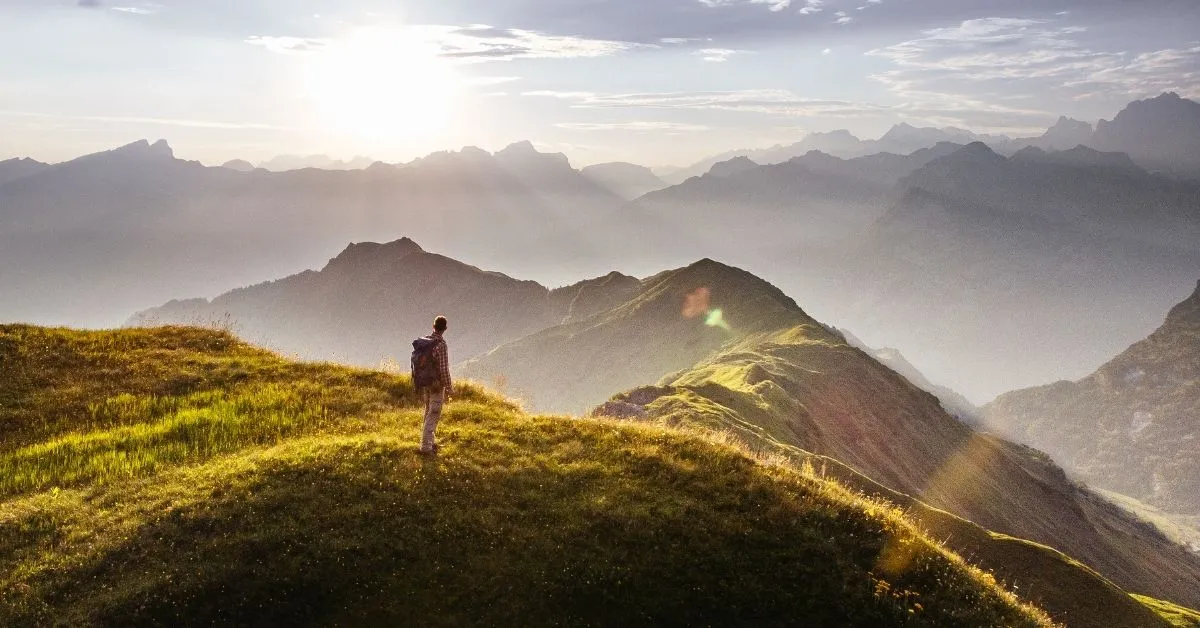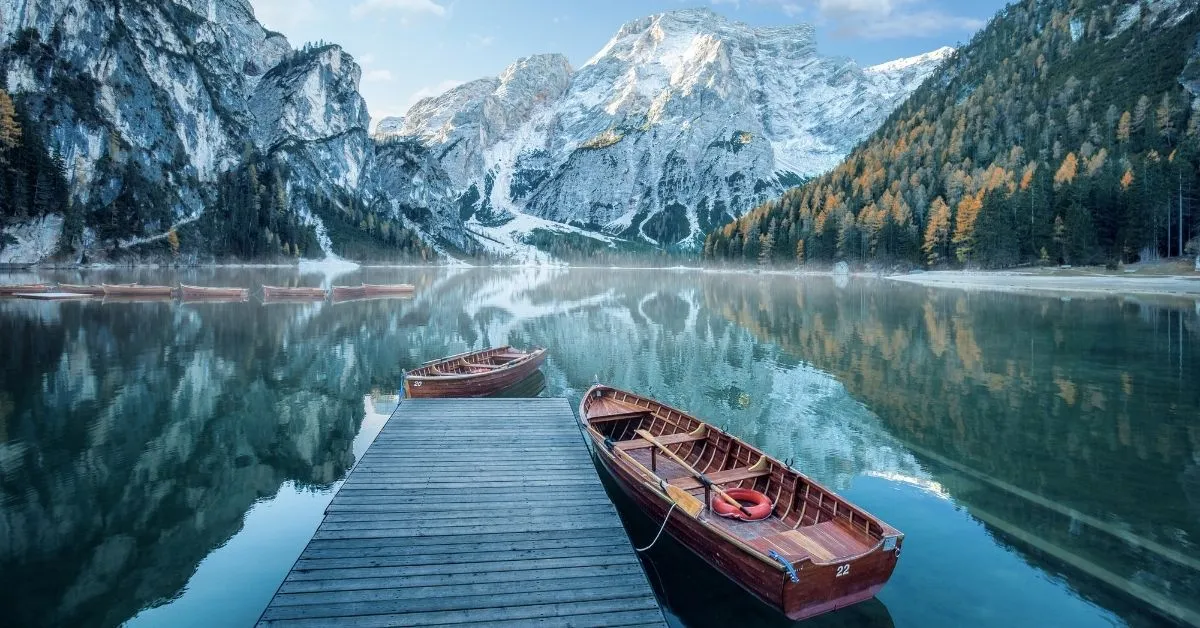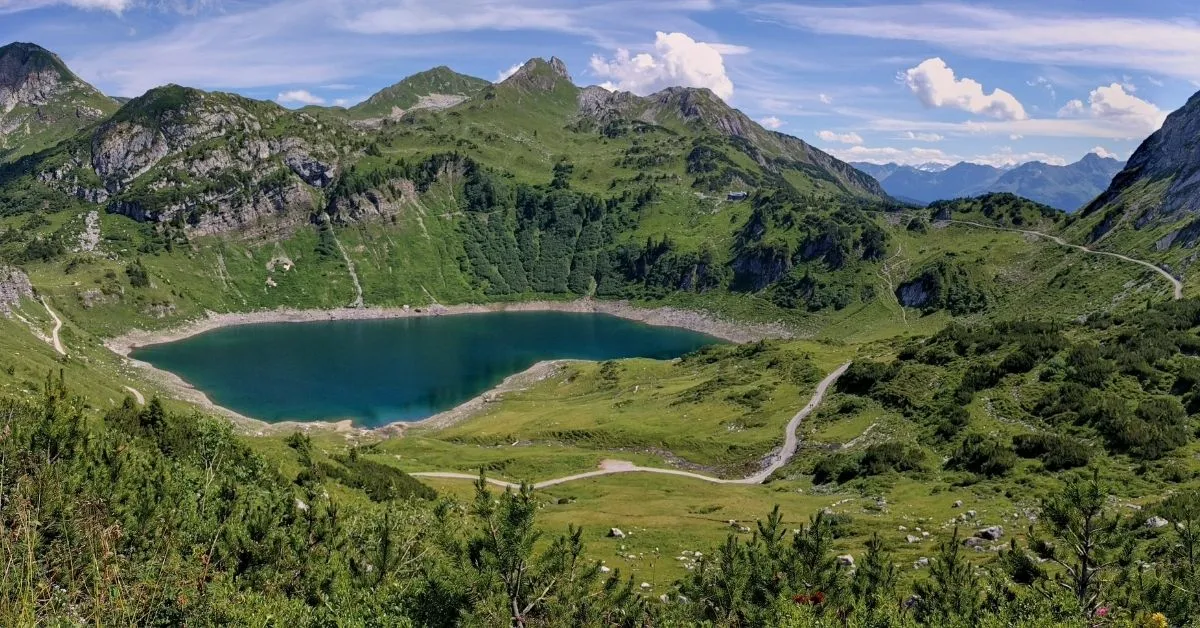The Alps are undeniably one of the most famous mountain ranges globally, holding a high spot on many travelers’ bucket lists.
What’s more, the Alps are the highest and most extensive mountain range in Europe, covering almost 300,000km² of land and spanning across eight countries.
Ready To Travel? Don't Go Without Travel Insurance.
I recommend SafetyWing Nomad Insurance, an affordable travel insurance offering automatic monthly payments that you can cancel anytime. I've been using it since 2019, and I can assure you it's the perfect solution for nomads like you and me. Learn more by reading our SafetyWing review.Hiking in the Alps makes for one of the most unique travel experiences and personal challenges. It’s not all about climbing tall peaks and reaching breathtaking views.
Hiking trails in the Alps connect many small villages and hamlets, offering trekkers a truly authentic experience of local life.
So, being such a vast system, how do you decide where to go trekking in the Alps?
France, Switzerland, Italy, and Austria are the four most popular countries for summer hiking in the Alps.
However, many of the best hikes in the Alps cross borders, and others are found in Slovenia, Germany, Liechtenstein, and Monaco.
In this guide, we’ll cover all the best hikes in the Alps and help you decide which one is for you.

Hiking In The French Alps
The French Alps offer a wide range of outdoor activities, from skiing to mountain biking to whitewater rafting.
Therefore, many travelers opt to go hiking in France to combine it with other activities, creating the ultimate adventure vacation.
In addition, the French Alps feature tranquil lakes in Annecy, lush forests in The Vercors, and limestone waterfalls in Cirque du Fer-à-Cheval.
It’s also home to Mont Blanc, the highest peak in the Alps, and the gorgeous Chamonix Valley that lies at its foot.
It’s best to visit the French Alps in summer, particularly from July to September, when the weather is at its best. Here are our top three hikes to do in the French Alps.
Tour Du Mont Blanc
- Distance: 170 km
- Duration: 8 – 11 days
- Intensity: Difficult
If you’ve done any research beforehand, you’ve probably already heard of Tour du Mont Blanc.
This multi-day trek is one of the most famous hikes in the Alps, with a total distance of approximately 170 kilometers circling around the highest peak in the range, Mont Blanck.
This trek is not for beginners, as it typically takes between 8 and 11 days to complete the entire loop. Moreover, it contains around 10 kilometers of ascending and descending, which can be steep and rocky.
However, the beautiful scenery this route provides draws avid explorers to it. What’s more, although it begins in France, it passes through parts of Italy and Switzerland, too.
On Tour du Mont, expect to walk about 20 kilometers a day with around 1km of ascents and descents. The tour traditionally starts in Les Houches village in the Chamonix valley.
As it’s a loop, you can choose which direction you go in. However, we highly recommend hiking anti-clockwise for the best views of the 4,696-meter tall mountain.
Cirque Du Fer-À-Cheval
- Distance: 10 km
- Duration: 4 hours
- Intensity: Moderate
For those looking for a day hike in the French Alps, the Cirque du Fer-à-Cheval trail is for you. This beautiful horse-shaped valley is located in the village of Sixt-Fer-à-Cheval on the French-Swiss border, 30km from Chamonix.
Here you will find the most waterfalls you have ever seen at once, running down the limestone cliffs and thundering into the valley below.
The 10-kilometer hiking trail is a short but moderately challenging route that loops through the valley and takes around 4 hours to complete.
The climb to the summit is surprisingly steep, and you’ll need a certain level of fitness for it. Even so, there are metal ropes that will help you get to the top, where you’ll be greeted by the smell of fresh coffee at the cabin there.
However, if the climb is too challenging, you can avoid the summit by taking one of the side trails that branch off instead.
Lac Blanc
- Distance: 4.9 km
- Duration: 2 – 4 hours
- Intensity: Easy to moderate
Lac Blanc is one of the most popular short trails among travelers hiking in France. It takes 2 to 4 hours to complete, making it an excellent choice for anyone on vacation in the region.
The hike is suitable for most people, but note that it is uphill for the first 1.5 to 2 hours as you ascend to an altitude of 2,352 meters.
The Lac Blanc trail sweeps through the Aiguilles Rouges nature reserve, takes you around a tranquil mountain lake, and gives breathtaking views over the Aiguilles de Chamonix, Les Drus, and La Verte.
This route has two starting points; the first is from Tré-le-Champ in Argentière, Chamonix.
From here, the trail is around 4.9 km with a 939-meter ascent. If you want to skip some inclines, you can take the La Flégère cable car up instead, reducing the climb to just under 500 meters.
Hiking In The Swiss Alps
Switzerland is home to almost all the highest mountains of the Alps, so naturally is a popular choice for hikers looking to explore the snow-capped mountains.
The scenery in Switzerland is unbeatable, with pristine beauty everywhere you look. As the climate is very similar to France, the best time to hike here is during the summer.
Aside from the dramatic landscape of the enormous peaks, you’ll find deep blue lakes, hamlets dotted with cute wooden huts, and some of the best ski resorts in the world.
Plus, all the cogwheel trains, funiculars, and cable cars make the Swiss Alps even more awesome.
This extensive transport network makes these gigantic mountains accessible to everyone, not only experienced mountaineers.
They also allow you to skip the most demanding climbs and shorten the length of some hikes.
As a result, everyone can enjoy hiking in Switzerland.
Tour Du Ruan
- Distance: 61 km
- Duration: 4 – 6 days
- Intensity: Difficult
The Tour du Ruan is a challenging 61 km route that takes 4 to 6 days to complete and straddles between Switzerland and France.
The multi-day trek will take you through the Haute-Savoie and Valais, giving spectacular views of the Bernese Alps, Rhone Plain, Valais Alps, Mont Blanc, and more.
The route is not well known, so expect fewer people on the trail. It takes you deep into the wilderness and goes as high as 2,829 meters.
It begins and ends at Lac d’Émosson, a reservoir in the canton of Valais, and can be done in either direction. However, the typical route is Emosson to Salanfe to Vogealle to Grenairon to Emosson.
Unlike other hiking trails in the Alps, the Tour du Ruan does not follow GR paths the entire time and is pretty off-the-beaten-path.
There is some signage around, but we still recommend doing this trek with an experienced tour guide.
Matterhorn Peak Trail
- Distance: 20 km
- Duration: 8 – 12 hours
- Intensity: Difficult
Matterhorn mountain sits on the border of Switzerland and Italy and has one of the highest summits in Europe.
You can reach the 4,478-meter tall peak by following a challenging 20 km trail that takes between 8 to 12 hours to complete.
Some hikers choose to complete it in one day, setting off at sunrise to make it back before it gets back.
However, this is only a good option if you have a high fitness level and previous hiking experience. Tackling the 1,569-meter elevation gain without a proper break is not for the faint-hearted!
A more enjoyable way to climb this mountain is to spread the hike over two or three days. This option allows you to break it down to 4 to 6 hours a day and rest overnight in the trail huts.
Zermatt is the closest town to Matterhorn. Set off from Zermatt camping ground, following the cable car line for a 3-hour ascent before reaching Schwarzsee Paradise.
From here, the trail flattens out so you can take in the marvelous views. The path then gets steep and slippery until you reach Hörnli Hut, where you’ll stay if you’re doing the multi-day trek.
From Hörnli Hut, you’ll follow the Glacier trail until the end, where you can take the cable car back down.
Mount Rigi Panorama Trail
- Distance: 15 km
- Duration: 2 – 3 hours
- Intensity: Easy
If you’re looking for some gentle hiking in Switzerland, head to the 1,798 meters high Mount Rigi for the spectacular panorama trail.
What’s unique about this peak is that it is almost entirely surrounded by water, including Lake Lucerne, Lake Zug, and Lake Lauerz.
This 15 km route is an out and back trail, primarily flat with a few steep but short sections. It is an excellent option for beginner hikers as it gives stunning views without much effort.
Plus, as Mount Rigi is only a 40-minute drive from Zurich, it’s a great way to combine some hiking in the Swiss alps with a vacation or backpacking trip through Europe.
The trail starts at Rigi Wölfertschen-First station and follows an old railway before opening out onto green valleys. Throughout the route, you’ll also walk through some partly shady forests along with following the mountain edge.
Be sure to check out the 360-degree viewing platform at Rigi-Kulm end station. And take a packed lunch as there are many lovely spots to stop for a scenic picnic lunch along the way.
Hiking In The Italian Alps
Now, let’s talk about the Italian Alps. There are multiple regions to explore in the Italian Alps, each offering a unique hiking experience.
Whether you want to spend a day or several days exploring the mountains, there are plenty of trails to choose from.
Some of the most popular hiking routes are located in the Dolomites, a mountain range known for its rugged peaks and stunning views.
That said, you’ll find other regions, such as the Aosta Valley, that are just as beautiful, with a wide range of trails to suit all skill levels.
The best time to go hiking in Italy’s Alps is during the summer when the weather is warm and sunny.
Sella-Herbetet Traverse
- Distance: 21 km
- Duration: 10 hours
- Intensity: Difficult
The Sella-Herbetet Traverse is a 21 km trail in Gran Paradiso National Park that begins and ends in Valnontey. The Gran Paradiso is the 7th highest peak in the Graian Alps, standing 4,061 meters above sea level.
The challenging day hike takes 10 hours to complete, so you’ll need to set off early for this one. Alternatively, if you want to take things at a slower pace, you can camp overnight along the way.
Breaking the hike up into two days makes it much more doable. Because the ascent is only 1180 meters, most of the second day will be descending.
Gran Paradiso National Park is a very off-the-beaten trail and not very well-known. Therefore, it’s one of the best hikes in the Alps if you’re looking to explore a truly wild part of the mountain range.
Along with pristine nature, there is a lot of wildlife in this protected area. The alpine ibex, chamois, and mountain hare are just a few examples of native animals you might spot here.
Croda Do Lago
- Distance: 11 km
- Duration: 3 – 6 hours
- Intensity: Moderate
The Croda do Lago circuit is an 11 km loop trail that is one of the most popular day hikes in the Dolomites.
It’s a challenging route with a fair amount of scrambling required, so it’s not a hike that you would want to rush.
Most people take 3 to 6 hours to complete it, depending on how many breaks you take.
The trail has an 867-meter elevation gain, taking you up high for spectacular views of the Dolomites. The route begins at the Ponte de Ru Curto bridge, just outside a small village called Pocol in Cortina d’Ampezzo.
The trail begins with a gentle uphill walk through the forest until you reach the start of the loop. Follow the path clockwise for the best views (and to avoid the steep incline at the beginning).
Heading left, you’ll continue uphill for another 30 to 40 minutes until you reach the Val Negra viewpoint at 2048 meters.
From here, the trail evens out a bit so you can enjoy the incredible perspective of the valley and mountains.
Tre Cime Di Lavaredo
- Distance: 9.5 km
- Duration: 4 hours
- Intensity: Moderate
Tre Cime di Lavaredo is a 9.5 km hike located in the Dolomites. If you only have one day to hike in the area, it can be a great option.
The trail is located in Tre Cime National Park, and the starting point is at Rifugio Auronzo. There will be an elevation of up to 2454 metres.
As you go up, you’ll see more and more of the peaks around you.
As it’s a round trip, you won’t be able to do it as a loop.
Hiking In The Austrian Alps
The mountains of Austria have some of the most beautiful hiking trails in the world. If you love being outdoors, then spending a few days exploring these majestic peaks is definitely something you should consider.
From challenging scrambles to more leisurely strolls, there’s something for everyone in this beautiful region.
When hiking in Austria, you can expect to see some incredible scenery. Whether you’re hiking through sun-drenched meadows bursting with wildflowers or walking beneath towering mountain peaks, the views are simply breathtaking.
Of course, it’s not all about the views. Hiking in Austria also allows you to immerse yourself in the local culture and get to know the people who call this beautiful country home.
You’ll find a wide range of day hikes and multiple-day hikes in Austria, making it the perfect destination for hikers of all levels.
The best time to go hiking in Austria is during the summer months (July to September), when the weather is warm and pleasant.
Pinzgauer Spaziergang
- Distance: 17 km
- Duration: 5-6 hours
- Intensity: Moderate
The Pinzgauer Spaziergang hike is a great way to explore the stunning beauty of the Austrian Alps.
A cable car will take you to the trailhead, where you’ll walk across the forest while you enjoy the views of the Kitzbühel and Hohe Tauern Alps.
As you go up, you’ll get to see Grossglockner and the Kitzsteinhorn Glacier.
The trail is well-marked, which makes it easy to navigate.
Rosengartenschlucht
- Distance: 5 km
- Duration: 3 hours
- Intensity: Moderate
This easy loop is ideal if you’re seeking an easy hike or a short hike in Austria. This hike starts in Imst, right across from the tourist office.
As you start walking, you’ll see a waterfall from the beginning.
As you reach the top, you’ll see parts of the Lechtaler Alps, the Blaue Grotte, and the Alpine Coaster (the world’s longest alpine roller coaster).
Final Thoughts On Hiking In The Alps
Whether you’re looking for a gentle day hike or extended trekking in the Alps, you’ll find your ideal trail on this list.
Regardless of which country you choose, we recommend trekking the Alps in the summer, particularly from July to September.
With sunshine, blue skies, and a low chance of rain, these spectacular mountain ranges look even more magical this time of year.
Want to read more about hiking? Read one of the following blog posts:






